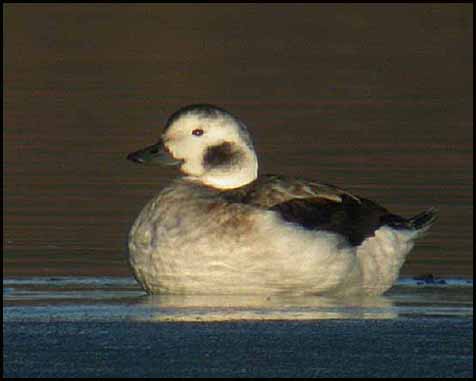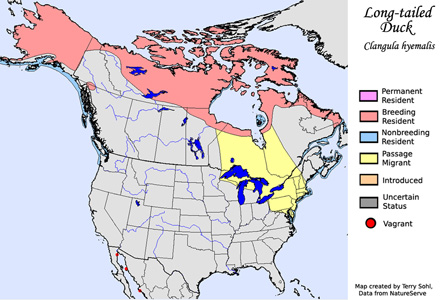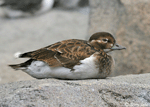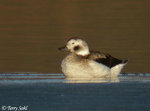Long-tailed Duck
Clangula hyemalis
| Length: 15 to 22 inches | Wingspan: 26 to 32 inches | Seasonality: Rare migrant/Winter |
| ID Keys: Extremely long tail on male. Plumages very different in summer and winter, but both with a short black bill with pinkish ring near the tip. | ||
 The Long-tailed Duck is primarily a bird of cold near-Arctic waters, where they are often the most common bird. They were
formerly called Oldsquaw, a reference to their very noisy and talkative behavior
(a name changed for reasons of political correctness). A
winter-plumaged female is shown in the photo on the right. Only the males have the extremely long
tail feathers.
The Long-tailed Duck is primarily a bird of cold near-Arctic waters, where they are often the most common bird. They were
formerly called Oldsquaw, a reference to their very noisy and talkative behavior
(a name changed for reasons of political correctness). A
winter-plumaged female is shown in the photo on the right. Only the males have the extremely long
tail feathers.
Habitat: In breeding season, they are found on low-lying tundra, barren ground in and around the treeline in the Arctic, other areas with open water nearby. In migration and winter, they are primarily found on the ocean, and also some on the Great Lakes and other large inland fresh water bodies.
Diet: Primarily feeds on mollusks and crustaceans at sea, as well as a few small fish. In summer breeding season, feeds heavily on aquatic insects, as well as crustaceans, mollusks, fish and amphibian eggs, and plant material.
Behavior: Capable of diving deeper than most ducks, Long-tailed Ducks feed by diving underwater and propelling themselves with their feet.
Breeding: Non-breeder in South Dakota
Song: Very loud ow-ow-owdle-ow calls that can be heard from up to a mile away.
Migration: Summers throughout much of northern North America. Winters along both the Pacific and Atlantic coasts of North America, usually from the northern half of the U.S. on northward.
Interactive eBird Map: Click here to access an interactive eBird map of Long-tailed Duck sightings
Similar Species: Due to long tail length, superficially similar to Northern Pintail. However, the species is generally distinctive.
Conservation Status: Still abundant through most of their normal range.
South Dakota "Hotspot": As they're only rare visitors to the state, there's no real "hotspot", but the majority of sightings have been along the Missouri River, especially below the major reservoir dams.
Further Information: 1) USGS Patuxent Bird Identification InfoCenter, Long-tailed Duck
2) WhatBird - Long-tailed Duck
3) Audubon Guide - Long-tailed Duck
Photo Information: November 11th, 2003 -- Lake Yankton below Gavin's Point Dam -- Terry L. Sohl
Additional Photos: Click on the image chips or text links below for additional, higher-resolution Long-tailed Duck photos.
| Click on the range map for a higher-resolution view |
 |
| South Dakota Status: Rare fall and spring migrant, casual in winter along the Missouri River. |
Additional Long-tailed Duck Photos
Click for a higher-resolution version of these photos


